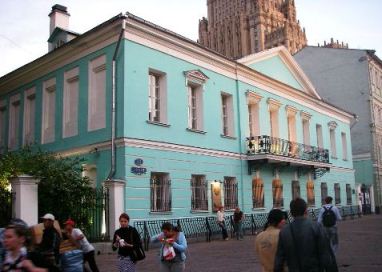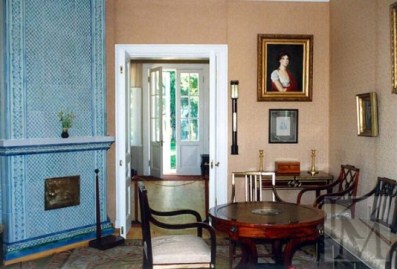

Ulitsa Arbat 53
Tel. (499) 241 9293
Subway: Smolenskaya
Open: 10am- 6pm Wed- Sun

A. S. Pushkin memorial apartment on Arbat is a small private
house that once belonged to Nikanor Nikanorovich Khitrovo. The
building was built in 1815 on the site of an old house that burned
down in a fire in 1812. Of course, the most famous guest of this
house is the famous Russian poet A. S. Pushkin, who settled here
with his young wife N. N. Goncharova from December 5, 1830 to may
15, 1831. Before his wedding, Pushkin spent his bachelor party here,
too.
Alexander Pushkin rented this elegant, blue and white
Empire-style apartment during the first three months of his marriage
to Natalia Goncharova. They were married in the Church of the Great
ascension on Bolshaya Nikitskaya street in February 1831, when she
was 18 years old. Pushkin wrote to his friend Peter Pletnev: "I'm
married and happy. My only wish: nothing in my life should change, I
don't expect anything better." However, by may 1831, Pushkin was
tired of life in Moscow, and the couple moved to St. Petersburg,
where, unfortunately, a tragic fate awaited him.
/3360567034_48cbdcbd83_m[1].jpg)
/3260727625_6b3faeb39e_m[1].jpg)
Entry from the book of the broker of the
Prechistenskaya part Anisim Khlebnikov
On the 23rd day of
January, 1831, I, the undersigned Mr. Alexander Sergeev son Pushkin
of the tenth class, entered into this condition with the servant of
Mrs. Safonova Semyon Petrov son Semyonov of the power of attorney
given to him by Mr. Nikanor Nikanorov son Khitrov of the provincial
Secretary, that on the 1st I, Pushkin, hired Mr. Khitrov's own
house, which consists in the Prechistenskaya part of the second
quarter at No. 204 in the parish of TS. Trinity, which is on the
Arbat, a two-story stone building with a mezzanine and attached to
it human services, kitchen, Laundry, stables, carriage house,
basement under the house, and there is also a spare barn, in the
house with furniture according to the attached inventory for a
period of six months from the date described above, and the period
is considered from January 22 to July 22 of this year 1831, under an
agreement between them for two thousand rubles in state banknotes,
of which I, Pushkin, pay him Semyonov, half of it, that is, a
thousand rubles in Bank notes, and the last half after those months
from the conclusion of the conditions, to take me, Mr. Pushkin house
with all facilities and furniture inventory<...> 6-e in buildings
occupied by me in a dark room off the bottom floor of the residence,
the housekeeper and the arrival of Mr. Khitrov. Alexander Sergeev's
son Pushkin put his hand to this record of the 10th grade
In 1884-1885, when the house belonged to Ivan
Patrikeev, the brother of the great Russian composer Anatoly Ilyich
Tchaikovsky settled here. He then lived on the second floor and his
brother Pyotr Ilyich Tchaikovsky often visited him when he came to
Moscow from the village of Maydanov in the Klin district, where his
house was located.
In 1921, the District Amateur theater of
the red Army (OSTKA) worked on the same second floor of the house.
The avant-garde theater was directed by V. L. Zhemchuzhny. In
General, the Soviet authorities, together with A.V. Lunacharsky,
supported new revolutionary ideas in art. Then the artistic Council
of the theater included such famous cultural figures as V. V.
Mayakovsky, V. E. Meyerhold and others. Among the actors of the
theater was a young actor Erast Garin. Later, the house was the site
of the military Tribunal of the Moscow military district during the
Great terror and Stalin's purges. Later in the house there were
communal apartments.
It was only in the 1980s that the idea
to turn the house into a Memorial apartment for Alexander Pushkin
appeared. The new Museum opened on February 18, 1986. Although
things have little to do with the poet himself, the interior is
nevertheless recreated quite well.
The fascinating
exhibition, located in the rooms of the first floor of the Museum,
gives an idea of what the city was like during the period when
Pushkin was growing up, before the great fire of 1812. Among the
engravings of lithography and watercolors are some unusual wax
figures of the orchestra of serfs, which belonged to the Goncharova
family. Pushkin and Natalia lived on the first floor. There are very
few personal items, although the poet's writing Desk and some family
portraits have been preserved. The atmosphere is more like a temple
than a Museum.
Exposition
The Museum's exhibition
space occupies two floors of the mansion. On the first floor there
is a permanent exhibition "Pushkin and Moscow", and on the second —
the memorial rooms of the Pushkin family. Despite the fact that the
authentic furniture was not preserved, the interiors of the rooms
were restored according to the memoirs of Pavel Vyazemsky, who often
visited the family.
In the front room of the memorial part of
the exhibition there are photos of friends and relatives of the
poet: Denis Davydov, Pyotr Vyazemsky, the poet Nikolai Yazykov, the
publisher of the Moscow Bulletin magazine Mikhail Pogodin, Nikolai
Yusupov, Evgeny Borotynsky, and the composer Alexey Verstovsky. The
Museum owns a Grand piano purchased by Sergei Rachmaninoff, which is
used at Museum musical evenings.
In the second memorial hall
was the Pushkin dining room, now there is a Desk-Desk with a copy of
one of the poet's poems, a copy of the portrait of Pushkin by Vasily
Tropinin, made by Avdotya Elagina commissioned by Sergei Sobolevsky.
The next room is dedicated to Natalia Goncharova, it exhibits an
original table that previously belonged to the poet's wife, and
portraits of Pushkin and Goncharova, painted by Peter Sokolov and
Ivan Makarov in 1836 and 1849, respectively. The last two memorial
rooms are former bedrooms of the family, they contain copies of
Pushkin's handwritten sheets, including the work "Eugene Onegin".
in 2015, the Museum received a copy of the monument to Catherine
II, the original was made as a gift to the Empress by Goncharova's
great-grandfather Afanasy in 1788. For a number of reasons, the
monument was never sent, and later passed to Pushkin as a dowry. In
1836 year, the poet sold the effigy to the alloy foundry of Franz
Byrd for three thousand bills.